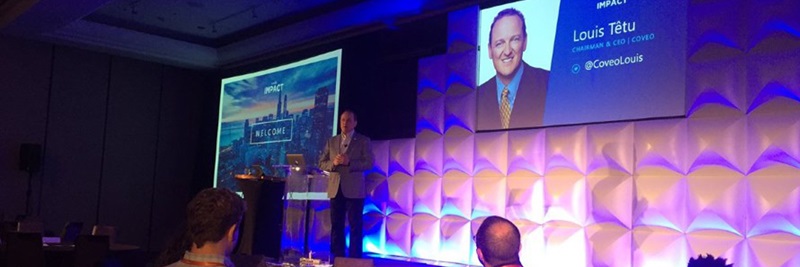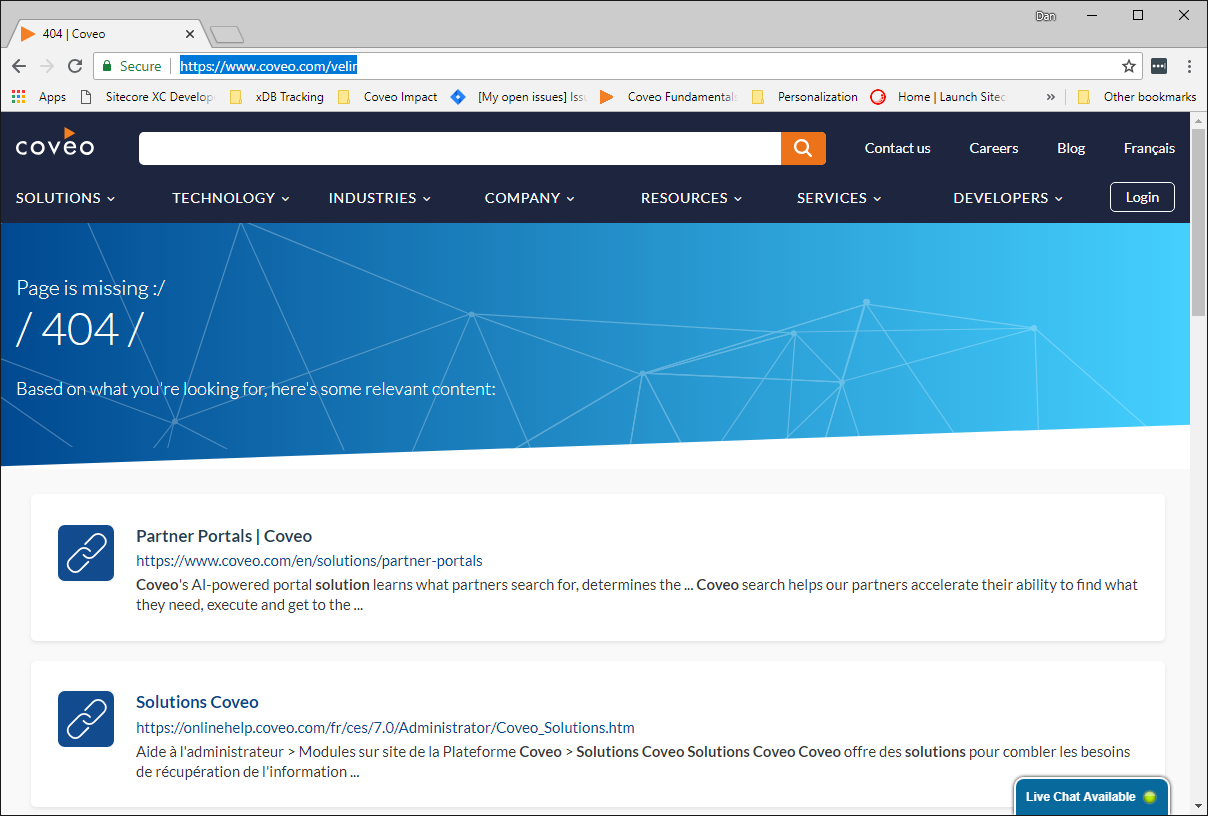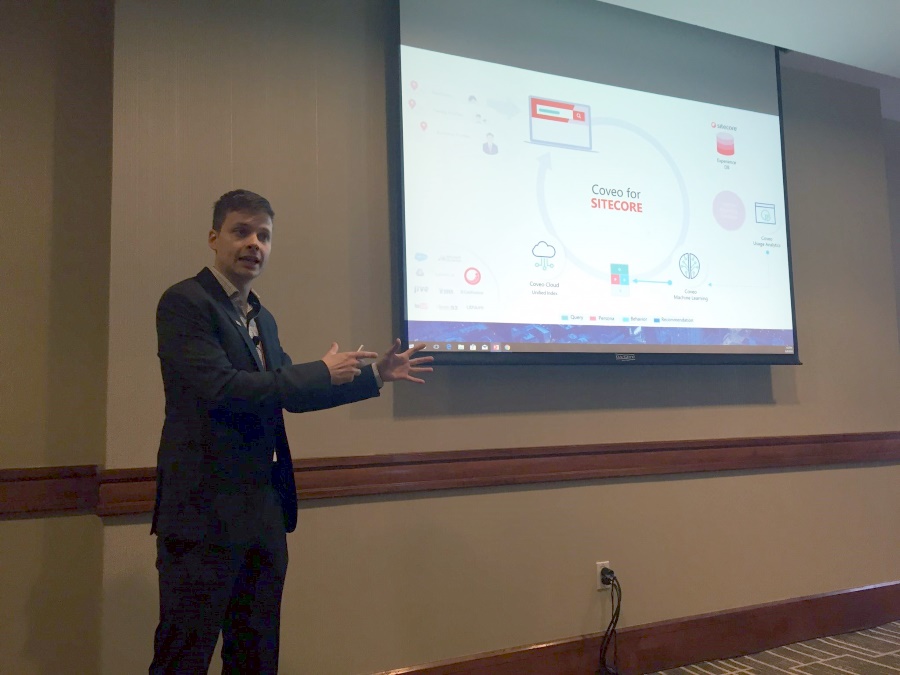Insights from Coveo Impact 2018

I recently received an invitation to attend the Coveo Impact conference in San Francisco. Below, I share my impressions of the event and Coveo’s strategy and vision.
Winning at Every Interaction: Coveo’s Vision
When Louis Têtu, CEO of the Quebec-based search provider Coveo, took the stage at the Coveo Impact conference (which took place in San Francisco from June 6-8th), he made clear both the ambition and vision of the company. Coveo, “a ridiculously ambitious company,” plans to dominate the fight for relevance, and by so doing, allow organizations to empower both their employees and their customers to do more. He contrasted the efficient employee, who can do the same thing faster, to the proficient one, who can do more things. To enable this flexibility, you need to get visitors and employees the information they are looking for, and to do that, you need to decipher their intent. And to do that, you need machine learning.
Coveo’s vision is that by observing the actions of thousands of queries, watching what terms get replaced by what other ones, and seeing what items actually get clicked on, you can get a bead on what someone is looking for, or what someone might want to look for next. And by doing that, you save users time, which is probably the one thing that users value more than anything else. When the site reads your mind, and gets you just what you need, you have a great experience, and you reward that site with loyalty. And you get employees who can quickly find the information they need, and so feel confident to do more and different things.
To realize this vision, you need the ability to combine different sources of data, the website, the support portal, and the internal knowledge base, into a single, unified index. The theme of the unified index as a shortcut to migrating systems, and a way to bridge organizational silos, was a recurrent motif in the conference. For example, Dell spoke about how they used Coveo to combine the inventory of a company it acquired (EMC), and there was a very impressive demo of how Salesforce, integrated with Coveo, could generate search results from internal data sources based on the content being entered into a support case. The more detail you put into the ticket, the more relevant the results in the right panel were, creating a positive feedback loop which would result in either a detailed support case, or perhaps no case being created at all, as the answer was surfaced through search. Coveo calls the latter happy circumstance “case deflection”.
The power of serving relevant results goes beyond lowering your case volume though. One of the most inspiring moments of the conference was when Sarah Franklin, general manager of the Salesforce Trailhead product, spoke. In looking at this site, I was struck by how inviting it was, breaking up the Salesforce product into a series of small, bite-size chunks—small “trails” you could explore.
Ms. Franklin spoke of the challenges facing IT, the shortage of talent, the cost of education, and the imperative of supporting a diverse workforce. She shared stories of lives that had been changed by people taking control of their careers through self-training on this site. In Franklin's words, “Trailhead democratizes education, removes friction, and allows people to change careers.” And key to this success is providing an appropriate set of “trails” for the student to embark upon based on their current activity and history, and the past behavior of their fellow explorers. And this selection of relevant content—inviting people to go take the next logical step—based not on a fixed script, but organically generated based on thousands of users’ interactions, was built in Coveo. This was a “there’s probably something to this” moment for me.
Your Website Visitors are Telling You What They Want to See
One of the most compelling talks was given by Stephanie Yamkovenko, digital editor at the American Occupational Therapy Association (AOTA). The main theme of her presentation was that the search box is where your association members are telling you what they want to read. She told a compelling story about the aftermath of the 2016 election, where a number of articles with titles like “Impact of the Election on…” were not being found by association members who were using the search term "Trump". This led to a change in editorial content, and this change was driven by data. She went deeper into this theme, explaining how looking at the search terms used on individual pages can highlight content people were looking for there, suggesting editorial changes, or links to other content. Top search terms can seed your content creation calendar, or indicate posts that should be promoted on social channels, like an association's Facebook page.
After her presentation, I spoke to Stephanie Yamkovenko about the value of Coveo for associations (an industry that is of significance to us, as we work with many great association clients). She shared, “Associations produce a lot of content, content they want their members to have access to. Getting the relevant piece of content to the person that needs it is pretty critical.”
Shoes for the Cobbler’s Children
There was a very interesting session given by the Coveo website team, about how Coveo was being more effectively leveraged by Coveo’s own website, using tools like Sitecore content profiling to focus the home page experience (are you a developer? a decision maker?) and fully using Coveo search inside the documentation site. A particularly compelling idea: integrating search into the 404 content not found page, using the name of the page you were searching for to serve up relevant content. For example, navigating to https://www.coveo.com/velir brought up a link to the Partner Portals page:

Integrating search into the 404 "content not found" page.
This is a small sample of how creative use of search technology can create surprisingly satisfying moments, the “winning at every interaction” spoken of during the keynote.
Internally at Coveo, innovation on how to use the product is driven by activities like regular one-day and two-day hackathons. One result: “people search”, allowing employees to locate colleagues (or conference rooms) using search, with results' contextual relevance boosted by machine learning.
People search at coveo internal. #CoveoImpact pic.twitter.com/9ztpoQI3aO
— Dan Solovay (@DanSolovay) June 7, 2018
Room search was one of my hackathon project.
— Jeff L'Heureux (@jflh) June 7, 2018
Training the Potential with Sitecore xDB
As a Sitecore specialist, I found the way that xDB visiting patterns is being used to fine-tune Coveo’s machine learning algorithms to be a very intriguing story. Pet Supplies Plus is using xDB to determine whether visitors are cat or dog fanciers (and big dog or small dog people, etc.) based on their patterns of content browsing over recent visits. Given that xDB thinks you are a cat person, Coveo can then give you results for a search term like “toys” that fine-tunes results based on the behaviors of other cat people. As the Sitecore product manager at Coveo, Simon Langevin, put it: “Machine learning is like a child with a lot of potential, but you need to make sure that potential is being put in the right place, and that is where xDB can help you.”
I had a conversation with CMO Mark Floisand at the end of the conference where he gave a particularly compelling example of this. “Take the word ‘console’. To a gamer, that means an xBox, a Playstation. To an IT guy, that means a terminal console, a rack component for a data center. And if you show the wrong one to the wrong person, they’ll say, “what is this stuff?” and bounce.” Gauging intent is key to producing a relevant experience, and relevance is key to keeping your customer around.

Simon Langevin, Coveo for Sitecore Product Manager
Simplifying Machine Learning, Simplifying Relevance
My final takeaway from the conference is how Coveo is democratizing the move to machine learning. Creating machine learning models, attaching them to query pipelines, and A/B testing one model against another, are all straight forward actions in the Coveo Cloud UI. Indeed, the move to the Cloud was motivated by the desire to simplify the installation experience. Making this technology focused, fast, and easy is key to driving its adoption. The focus on making the developer and administrator experience simple and streamlined seemed very promising. The conference left me eager to dive into this area.
Have you worked with Coveo’s solutions? We’d love to hear your experiences. Feel free to share your thoughts below or Tweet Us @Velir!



